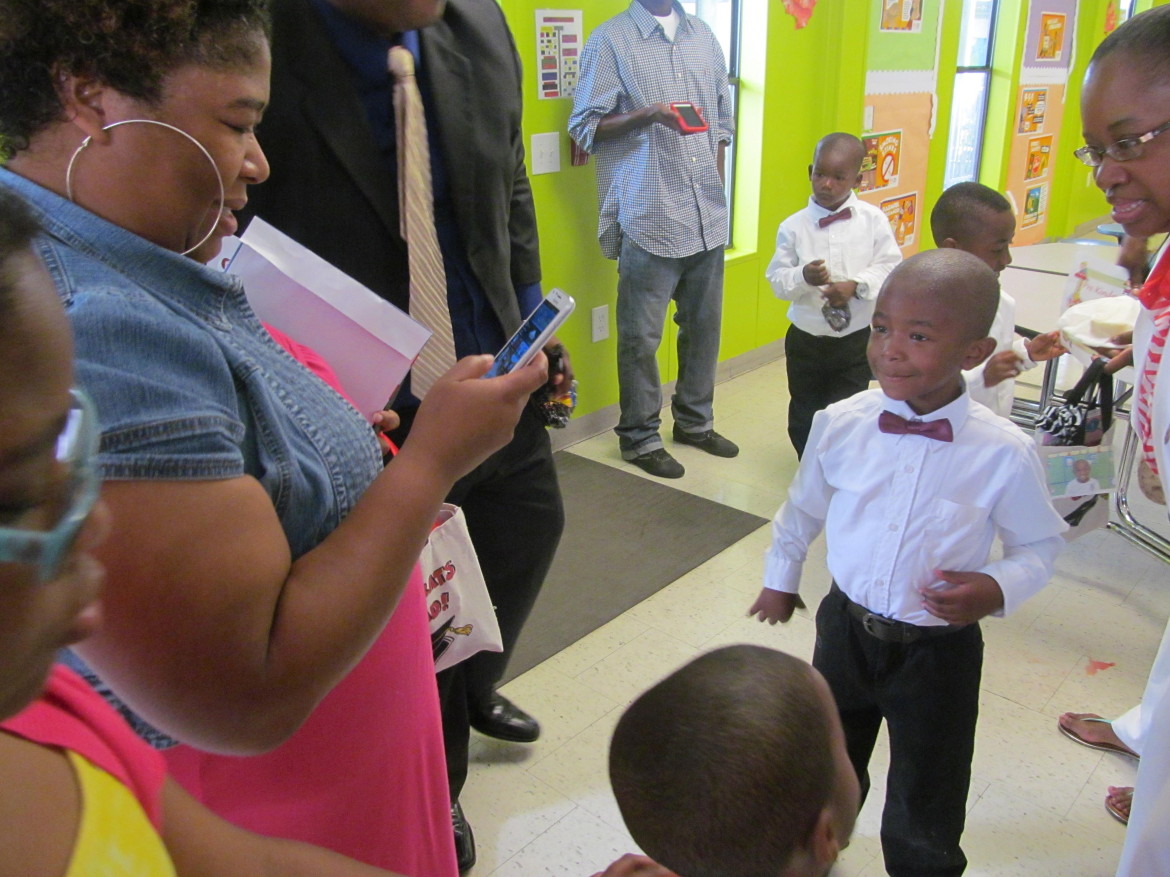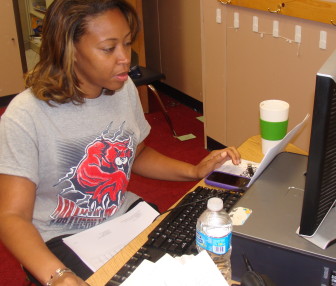
It’s the next-to-last day of the school year at Benjamin Mays Preparatory School. Wearing crisp white dresses and smart button-down shirts and slacks, a group of pre-kindergarten and kindergarten students walk into the packed cafeteria and chant slogans. “But don’t you cry and don’t you fret, I’m not done learning yet!”
Friends and family push through the crowd wielding cameras, phones and iPads, ignoring the principal’s repeated appeals not to block the view.
Mason Garner is one of the kindergartners. Wednesday’s graduation didn’t mark his transition to another classroom at the school; it meant the end of his time at Mays — and the end of Mays itself.
With the school closing, students such as Mason and his sister Maya, as well as their teachers, will scatter across the city.
Mays is one of four New Orleans public schools closing this year, along with Abramson Elementary, James Weldon Johnson Elementary School and Murray Henderson Elementary School. A wrenching process for both families and faculties, closing down failed and unneeded schools is the anvil on which a market-driven school system is trying to forge a stronger set of survivors.
“I went to four schools my entire life,” said Malaika Amedee, the mother of two students who are leaving Mays Prep. “I don’t know how this is going to affect them.”
Mays is the only charter school that’s closing. The others are run by the Recovery School District; they’re being closed, district officials say, because of demographic shifts and there are seats in higher-performing schools.
Charter schools live or die depending on whether they meet certain academic targets within three to five years. If they don’t, two things can happen. The school can be handed over to another charter organization to bring its own staff in and try to turn it around. Or the school can be closed and its charter revoked, leaving students and teachers to find new schools.
Mays’ school performance score was a dismal 53.3 out of 200 in its third year of operation.
Charter school proponents, such as American Federation for Children executive counsel Kevin Chavous, praise tough accountability systems. Closures mean kids don’t languish in schools that have underperformed for years, Chavous said.
Malaika Amedee, Mason and Maya’s mom, and other parents have more on their minds than school performance scores. They’re worried about how their children will adjust.
Though Amedee has heard good things about her children’s new school, Morris Jeff Community School, she doesn’t know if they’ll be as attentive to Mason, who rarely sits still for more than a few minutes. Another worry: Morris Jeff will be Maya’s third school, and she’s only entering third grade.
“They just keep getting these kids used to somebody, and every year it’s always something,” Neshandra Hill said, whether it’s a new principal or a new crop of teachers. “Now the whole school is closing.”
“I went to four schools my entire life,” Amedee said, counting them on her fingers. She frowned. “I don’t know how this is going to affect them.”
Critics of school closures say stability is a big factor in a student academic success. Regardless of whether schools are closed because of low academic performance or declining enrollment, it’s still hard on displaced students, said Pauline Lipman, who teaches education policy at the University of Illinois at Chicago.
Research shows “that student mobility negatively impacts students educational progress,” Lipman said. “Some of that is academic and some of that is emotional.”
A pattern around the nation
School closures are not unique to New Orleans, where in 2012 the population was still 25 percent lower than before Hurricane Katrina. In Chicago, 50 schools will close this year. Critics argue that the closures will hurt surrounding communities, but district officials say they have to cut costs and get rid of underused school buildings. In March, Philadelphia officials cited similar reasons for shutting down 24 schools.
[module align=”right” width=”half” type=”pull-quote”]The phase-outs and the closures are part of a larger plan to pare schools down to fit New Orleans’ smaller, shifting population.[/module]Despite such closures, the total number of schools in the U.S. has remained stable in recent years as new schools have opened to replace closing ones.
Former state Board of Elementary and Secondary Education member Leslie Jacobs, who has advocated for greater accountability in schools, said the arguments for and against school closures both have merit.
“School closings across the country are always disruptive,” she said. But in the long run, “letting failing schools continue to operate is not the answer, either.”
New school year means new teachers, new schools
The change is particularly worrisome for Abramson parent Neshandra Hill. Her son Lavance, 13, struggles with bipolar disorder. Hill says she’s “terrified” for Lavance as Abramson shuts down. The school’s newly installed staff had just begun to figure out what can trigger one of his episodes.
“They just keep getting these kids used to somebody, and every year it’s always something,” she said, whether it’s a new principal or a new crop of teachers. “Now the whole school is closing.”
Lavance has been at Abramson since he was in first grade, when the school was a charter under the Pelican Educational Foundation. Hill said she and other parents had come to love the faculty. That’s why they fought to keep the school under Pelican’s control, despite an alleged bribery of a state education official and a 2011 state investigation that raised additional questions about student safety and supervision.
Repeated trips to Baton Rouge to ask the state education board to stop the charter from being revoked proved unavailing. RSD took over the school in 2011. Each of the next two years, a new principal showed up to run Abramson.
Closures part of larger plan
The Recovery School District, the state-run entity that assumed control of the city’s failing schools shortly after Hurricane Katrina, has said from the start that its role is temporary.
The phase-outs and the closures are part of a larger plan to pare schools down to fit the city’s smaller, shifting population, said Cay Kimbrell, RSD’s chief of staff for external affairs. Henderson is in Algiers, where state and local education officials are also merging two high schools because of low enrollment. Two of the other schools are in eastern New Orleans and the 9th Ward, both of which have not rebounded as much as other areas.
[module align=”right” width=”half” type=”pull-quote”]School closings across the country are always disruptive,” said Leslie Jacobs, a longtime advocate for school accountability. But “letting failing schools continue to operate is not the answer, either.”[/module]RSD also wants to hand its schools off to charter operators that have boasted academic gains.
To help families adjust, RSD held a school fair for Mays parents in February. Mays students also got first preference at every other RSD school in the city, after those schools enrolled their returning kids.
Of the Mays students who completed an application during the first round of OneApp, the city’s common enrollment process, 88 percent got into one of their top three choices, said RSD Director of Enrollment Gabriela Fighetti.
The average school performance score of the schools that Mays students were assigned to in that first round was an 86, according to RSD data. That’s 33 points higher than Mays’ 53 — but it’s still a D under the state’s grading system.
Demographics blamed for traditional school closures
Though Mays is being shuttered due to poor performance, the traditional schools that are closing for demographic reasons have done well in high-stakes testing this year.
At Abramson, more than 70 percent of fourth- and eighth- graders scored at or above grade level on the state’s high-stakes tests in English and math.
Murray Henderson Elementary’s scores were among the highest in the city – 94 percent of fourth-grade students scored at or above grade-level in English, and 99 percent did so in math.
Edward Brown, Abramson’s principal, said that he wished the scores had been considered in RSD’s decision to shut the school down.
“We actually outperformed the school that they are going to,” Brown said, referring to Schaumberg Elementary, the school in eastern New Orleans that will receive most of Abramson’s students. “Why not keep us open? Why not give us another year?”
Instead, Schaumberg will live on as a charter school operated by ReNEW Schools.
Abramson’s fourth- and eighth-graders scored higher than Schaumberg’s on this spring’s tests, though Schaumberg had a higher school performance score for the current year.
Teachers on the move

Brown and assistant principal Jackie Mahatha jokingly call themselves “transition specialists.” This is their first year at Abramson. Before this, Mahatha was principal at Joseph Craig Elementary, which was chartered last year. Before that, she was assistant principal at Albert Wicker Elementary, which has since turned into Success Preparatory Academy.* And before Katrina, she ran Alfred Lawless High School.
Neither Brown nor Mahatha know where they’ll end up next year. Most of Abramson’s nearly 30 teachers haven’t been placed yet either.
“It’s tough, because I get phone calls … and it’s like we’re all applying for the same jobs,” Brown said. The four remaining traditional schools that RSD will run next year are in high demand, he explained, because RSD, unlike most charter schools, still offers pension benefits.
Still, Brown’s not limiting himself. He’ll work at a charter school again if he can find a position.
Mahatha feels the same way. As a 22-year veteran, she thinks she’ll have a harder time finding a job than lesser-paid administrators. Still, she’s confident that “people still want hard working people,” whether they’re newer educators or veterans.
Laughing to keep from crying
The closures have been emotional for both educators and parents. Mays parent Kenisha Nelson has been known to break down in public meetings when describing her love for the teachers at Mays.
Abramson teacher and parent Erica Larkins began to cry when asked what she will most miss about her time at Abramson. “The kids,” she immediately said, “and the staff.” She’s thinking of working in higher education next.
On May 24, the day after students left Abramson for the last time, Larkins and her colleagues held a mock funeral for the school. A tongue-in-cheek obituary in the program read: “Abramson Elementary was born June 24, 2012, to Edward Brown and Jacquelyn Mahatha. He died May 24, 2013, of undetermined causes.”
A stuffed wildcat was placed in a cardboard coffin and perched atop a decorated table in the cafeteria. Teachers sang and spoke words of remembrance. Larkins even performed a mock interpretative dance for the bereaved “sons and daughters of Abramson.” Laughter abounded throughout the ceremony.
“Sometimes we have to laugh and make light of the situation to keep from crying,” Brown said to staff.
Amedee hasn’t been as publicly emotional as other parents. Morris Jeff was her top choice for Maya and Mason, and she’s glad they’ll continue to attend school together. Still, her concern about them moving again shows what it’s like to be part of a school system that fosters constant change:
“My fear is, is this going to happen again in four years?”
*Correction: This story originally misstated the name of Success Preparatory Academy. (May 31, 2013)

